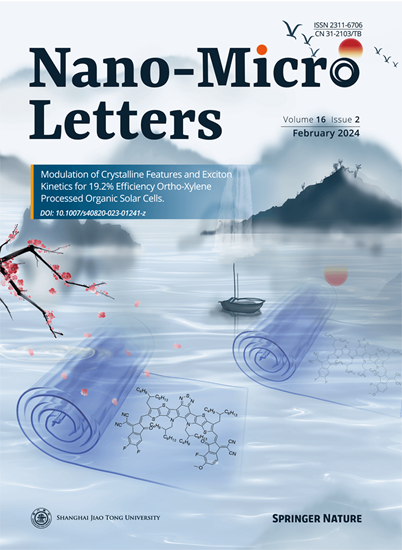Pickering乳液驱动的MXene/丝素水凝胶具有可编程功能网络,用于电磁干扰屏蔽和太阳能蒸发。
IF 36.3
1区 材料科学
Q1 Engineering
引用次数: 0
摘要
具有柔性和相容性的纳米材料基功能水凝胶在各个领域都有很好的应用前景。然而,对水凝胶中功能电子/质量输运网络的可控操纵仍然是相当具有挑战性的。我们描述了一种通用和通用的无表面活性剂乳液构建策略,以定制具有可编程分层结构的强大功能水凝胶。值得注意的是,丝素蛋白(SF)的亲和性和MXene纳米片的增强作用产生了不需要任何表面活性剂的紫貂皮克林乳。随后的微相分离和溶剂交换诱导的SF链自交联将复合乳液转化为具有可调微结构和功能的高性能水凝胶。作为概念验证,有序导电网络的可控调节和水极化效应使水凝胶具有良好的电磁干扰屏蔽效率(~ 64 dB)。此外,调节功能水凝胶的微观结构,以提高传质/传热性能。SF的氨基酸和MXene的表面末端有助于降低水的蒸发焓,而水凝胶的层次结构加速了蒸发过程,与其他水凝胶蒸发器相比,期望有更好的蒸发性能(~ 3.5 kg m - 2 h - 1)和耐盐能力。我们的发现为生产具有集成结构依赖性质的功能性水凝胶装置提供了大量机会。本文章由计算机程序翻译,如有差异,请以英文原文为准。
Pickering Emulsion-Driven MXene/Silk Fibroin Hydrogels with Programmable Functional Networks for EMI Shielding and Solar Evaporation
Highlights
-
A versatile surfactant-free emulsion construction strategy is proposed to customize functional hydrogels.
-
The synergistic emulsification mechanism between amphiphilic polymers and MXene is comprehensively elucidated.
-
Programmable functional structures confer hydrogels with excellent EMI shielding and water evaporation performance.
求助全文
通过发布文献求助,成功后即可免费获取论文全文。
去求助
来源期刊

Nano-Micro Letters
NANOSCIENCE & NANOTECHNOLOGY-MATERIALS SCIENCE, MULTIDISCIPLINARY
CiteScore
32.60
自引率
4.90%
发文量
981
审稿时长
1.1 months
期刊介绍:
Nano-Micro Letters is a peer-reviewed, international, interdisciplinary, and open-access journal published under the SpringerOpen brand.
Nano-Micro Letters focuses on the science, experiments, engineering, technologies, and applications of nano- or microscale structures and systems in various fields such as physics, chemistry, biology, material science, and pharmacy.It also explores the expanding interfaces between these fields.
Nano-Micro Letters particularly emphasizes the bottom-up approach in the length scale from nano to micro. This approach is crucial for achieving industrial applications in nanotechnology, as it involves the assembly, modification, and control of nanostructures on a microscale.
 求助内容:
求助内容: 应助结果提醒方式:
应助结果提醒方式:


